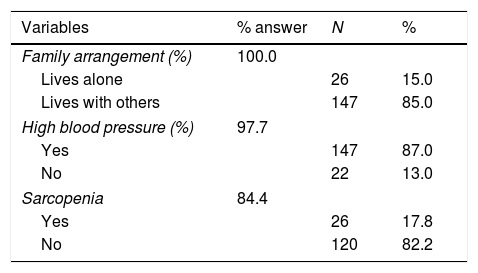To investigate the association between sarcopenia and different anthropometric indicators, and identify the best indicator to discriminate sarcopenia in community-dwelling older adult women.
MethodData from 173 older adult women (≥60 years), living in Lafaiete Coutinho, a small-sized city in northeastern Brazil, were analyzed. Sarcopenia was defined based on the European consensus on definition and diagnosis using three components: muscle mass, muscle strength and performance. The association between sarcopenia and anthropometric indicators (body mass index, corrected arm muscle area and calf perimeter) was tested using the binary logistic regression technique.
ResultsThe adjusted regression model indicated that all anthropometric indicators were inversely associated with sarcopenia, and an increase by one unit in body mass index, corrected arm muscle area or calf circumference decreased the probability of sarcopenia in older adult women by approximately 85%, 16% and 72%, respectively.
ConclusionAll the studied anthropometric indicators can be used as discriminators of sarcopenia in an older adult women population. To this end body mass index exhibited better sensitivity and calf circumference better specificity. The results of the study may improve nursing practice and that of other healthcare professionals, enabling sarcopenia screening in older adult women from simple and low-cost anthropometric indicators.
Investigar la asociación entre sarcopenia y diferentes indicadores antropométricos, y evaluar qué indicador discrimina mejor sarcopenia en mujeres ancianas residentes en la comunidad.
MétodoFueron analizados datos de 173 mujeres ancianas (≥60 años), residentes en Lafaiete Coutinho, una pequeña ciudad en el noreste de Brasil. La sarcopenia se definió con base en el consenso europeo sobre definición y diagnóstico mediante 3 componentes: masa muscular, fuerza muscular y rendimiento. La asociación entre sarcopenia y los indicadores antropométricos (índice de masa corporal, área muscular del brazo corregida y perímetro de la pantorrilla) fue testada por medio de la técnica de regresión logística binaria.
ResultadosEl modelo de regresión ajustado indicó que todos los indicadores antropométricos fueron inversamente asociados a la sarcopenia, siendo que el aumento en una unidad en el índice de masa corporal, área muscular del brazo corregida o perímetro de la pantorrilla disminuyó en aproximadamente un 85, un 16 y un 72%, respectivamente, la probabilidad de sarcopenia en las mujeres ancianas.
ConclusiónLos indicadores antropométricos estudiados pueden utilizarse como discriminadores de sarcopenia en una población de mujeres ancianas. El índice de masa corporal mostró una mejor sensibilidad y el perímetro de la pantorrilla, una mayor especificidad con este fin. Los resultados del estudio pueden mejorar la práctica enfermera y de otros profesionales de la salud, permitiendo la detección de.sarcopenia en mujeres ancianas a partir de indicadores antropométricos simples y de bajo costo.











